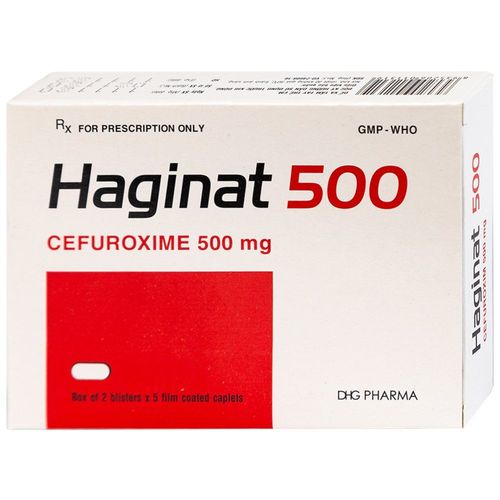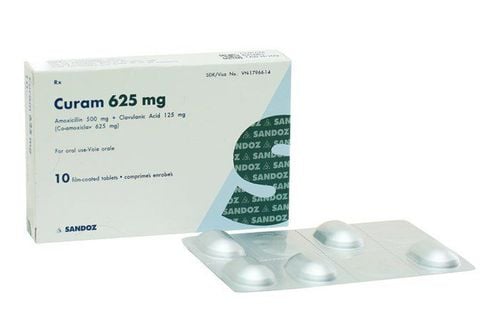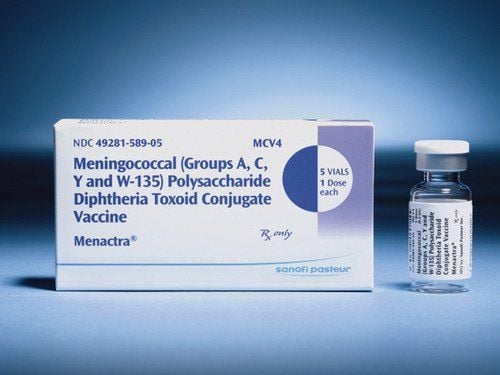This is an automatically translated article.
Ampicillin 1g is prepared as a powder for injection, with the main ingredient being Ampicillin. The drug is used in the treatment of respiratory infections, sinusitis, meningitis,...
1. Uses of Ampicillin 1g
What is Ampicillin 1g? The drug's main ingredient is Ampicillin - a broad-spectrum antibiotic that is effective against both gram-negative and gram-positive cocci. Regarding the mechanism of action, Ampicillin acts on the multiplication process of bacteria, inhibits the synthesis of mucopeptides of the bacterial cell wall, leading to effective killing of bacteria.
Ampicillin 1g is indicated in the following cases:
Treatment of upper respiratory tract infections caused by certain strains of bacteria; Treatment of sinusitis, exacerbation of chronic bronchitis, otitis media and epiglottitis caused by susceptible strains of bacteria; Treatment of meningitis caused by Pneumococcus, Meningococcus and Haemophilus influenzae; Treatment of Listeria infections (because this bacteria is very sensitive to Ampicillin). On the other hand, Ampicillin 1g is not indicated in the following cases:
People are sensitive to ingredients or excipients in the drug; People infected with herpes viruses, especially infectious mononucleosis.
2. Usage and dosage of Ampicillin 1g
2.1 Administration The drug is administered by intramuscular or intravenous injection.
For intramuscular injection, dissolve 1g Ampicillin with 3.5ml distilled water for injection; For intravenous/intravenous administration, dissolve 1g Ampicillin with 5-10ml of distilled water for injection. The reconstituted solution should be injected slowly for a minimum of 3 - 5 minutes for each dose of 250 - 500 mg over at least 10 - 15 minutes for a dose of 1 g. Ampicillin can be added to the solution for injection or infusion at the appropriate dilution.
About stability and compatibility:
Ampicillin 1g is unstable in solutions of glucose or other carbohydrates. Therefore, solutions containing Ampicillin should not be mixed with blood products or hydrolyzed protein solutions. For reasons of incompatibility, Ampicillin should not be mixed in the same container with Aminoglycosides; Ampicillin sodium injection solution should be injected immediately after reconstitution, not allowed to freeze. 2.2 Dosage Dosage for adults:
Suggestion: Intramuscular or intravenous injection slowly interrupted 3 - 6 minutes, 0.5 - 2g / time, every 4-6 hours / time or intravenous infusion; Treatment of sepsis or bacterial meningitis: Use a dose of 8-14g or 150-200mg/kg, injected into several times, each time 3-4 hours apart. For initial treatment in sepsis or infective meningitis, it should be given intravenously for at least 3 days, then possibly intramuscularly. Dosage for children:
Septicemia or bacterial meningitis: Use dose of 100-200mg/kg/day, divided into several small doses, spaced every 3-4 hours/time. It is recommended to start intravenous for 3 days, then continue intramuscularly; For infections other than meningitis: Newborns ≤ 1 week old: Dose 25mg/kg IM or IV every 12 hours (for children weighing ≤ 2kg) or every 6 hours (for babies weighing ≤ 2kg) weighing over 2kg); Newborns over 1 week old: 25mg/kg IM or IV every 8 hours (for children weighing ≤ 2kg) or every 6 hours (for children weighing over 2kg); With meningitis in children under 2 months of age: Use intravenous dose of 100-300mg/kg/day, divided into several times and combined with intramuscular Gentamicin. Dosage for patients with renal impairment:
Creatinine clearance ≥ 30ml/min: Use the usual adult dose; Creatinine clearance ≤ 10ml/min: Use the usual adult dose every 8 hours; Hemodialysis patients: An additional dose of Ampicillin is required after each dialysis period. The duration of treatment will depend on the type and severity of the infection. For most infections, treatment should be continued for at least 48-72 hours after the patient is symptom-free.
When an overdose of Ampicillin is used, neurological reactions (including convulsions) may occur if the concentration of β-lactams is high in the cerebrospinal fluid. The treatment is to remove Ampicillin from the general circulation by hemodialysis.
3. Side effects of Ampicillin 1g
Some side effects patients may encounter when using Ampicillin 1g:
Common: Diarrhea, rash (exanthema); Uncommon: Thrombocytopenia, eosinophilia, anemia, leukopenia, agranulocytosis, stomatitis, glossitis, nausea, vomiting, diarrhea, urticaria, colitis, pseudocolitis fascia; Rare: Anaphylactoid reactions, "late rash", exfoliative dermatitis and erythema multiforme. With side effects, if the treatment period is long with Ampicillin, it is necessary to periodically check the liver and kidneys. At the same time, it is necessary to carefully evaluate whether the patient has previously been allergic to penicillin or cephalosporin, other allergic agents. If there is an allergic reaction such as anaphylaxis, urticaria, Steven Johnson syndrome, ampicillin should be stopped and treated with Epinephrine (adrenaline) immediately. Thereafter, never again treated with Penicillin and Cephalosporins.
4. Be careful when using Ampicillin 1g
Some notes patients need to remember when using Ampicillin 1g:
Should test skin reactions before using Ampicillin. If the patient is hypersensitive to the drug, it is absolutely not used; If long-term treatment with ampicillin, the liver and kidney function should be checked periodically; To reduce local pain when injecting Ampicillin, it is recommended to inject deeply and slowly; Dissolved Ampicillin should be injected immediately. If you want to keep it, it should be stored in the refrigerator but not more than 24 hours; Beware of the risk of cross-resistance with Cephalosporins; Patients with renal failure should reduce the dose of Ampicillin; Pregnant and lactating women can use Ampicillin 1g with normal therapeutic doses but should strictly follow the doctor's instructions.
5. Ampicillin 1g . drug interactions
Some drug interactions of Ampicillin 1g include:
Avoid combining Ampicillin with Allopurinol because it may increase the risk of skin redness; Bacteriostatic antibiotics such as Tetracycline, Chloramphenicol, and Erythromycin may decrease Ampicillin's ability to kill bacteria. When using Ampicillin 1g, the patient should absolutely follow all the instructions of the doctor. This ensures the drug gives the best treatment effect and reduces the risk of unpredictable side effects and complications.
Please dial HOTLINE for more information or register for an appointment HERE. Download MyVinmec app to make appointments faster and to manage your bookings easily.













